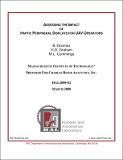Assessing the Impact of Haptic Peripheral Displays for UAV Operators
Author(s)
Cummings, M. L.; Donmez, B.; Graham, H. D.
DownloadHAL2008-02.pdf (3.481Mb)
Other Contributors
Massachusetts Institute of Technology. Dept. of Aeronautics and Astronautics. Humans and Automation Laboratory
Metadata
Show full item recordAbstract
Objectives: A pilot study was conducted to investigate the effectiveness of continuous haptic
peripheral displays in supporting multiple UAV supervisory control. Background: Previous
research shows that continuous auditory peripheral displays can enhance operator performance in
monitoring events that are continuous in nature, such as monitoring how well UAVs stay on their
pre-planned courses. This research also shows that auditory alerts can be masked by other
auditory information. Command and control operations are generally performed in noisy
environments with multiple auditory alerts presented to the operators. In order to avoid this
masking problem, another potentially useful sensory channel for providing redundant
information to UAV operators is the haptic channel. Method: A pilot experiment was conducted
with 13 participants, using a simulated multiple UAV supervisory control task. All participants
completed two haptic feedback conditions (continuous and threshold), where they received alerts
based on UAV course deviations and late arrivals to targets. Results: Threshold haptic feedback
was found to be more effective for late target arrivals, whereas continuous haptic feedback
resulted in faster reactions to course deviations. Conclusions: Continuous haptic feedback
appears to be more appropriate for monitoring events that are continuous in nature (i.e., how well
a UAV keeps its course). In contrast, threshold haptic feedback appears to better support
response to discrete events (i.e., late target arrivals). Future research: Because this is a pilot
study, more research is needed to validate these preliminary findings. A direct comparison
between auditory and haptic feedback is also needed to provide better insights into the potential
benefits of multi-modal peripheral displays in command and control of multiple UAVs.
Date issued
2008Publisher
MIT Humans and Automation Laboratory
Series/Report no.
HAL Reports;HAL2008-02